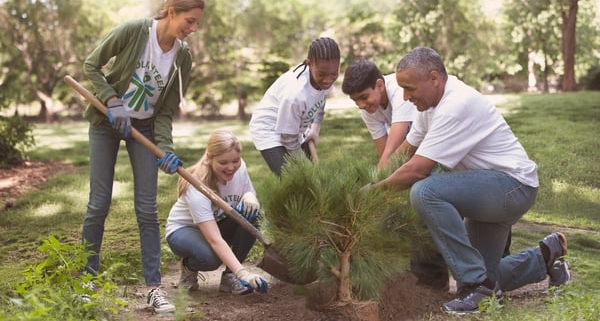Essential things to consider when planting a tree
Each year, Arbor Day is celebrated by families and organizations alike. The purpose of Arbor Day is to recognize the important role trees play in our lives and world. Planting trees not only adds beauty to our neighborhoods and city streets, but it’s also an important act of sustainability, especially if an area has been devastated by severe weather.
Before you pick up a shovel, here are several things to consider.
1. The type of tree. Selecting the perfect tree for your yard will involve some research. Things to consider include:
- Do you want a berry producing tree?
- Is the tree susceptible to disease?
- Do you want to enjoy flowers in the spring?
- Do you want to enjoy fall colors?
- Do you want a tree that will stay green all year round?
- Do you want a tree that attracts birds and is good for nesting?
- How fast it will grow?
If you feel overwhelmed, talk to your local landscape professional or nursery.
2. Location and space. Once you’ve decided on the perfect tree, it’s time to think about where you want to plant it. Never plant a tree directly next to your home as this can cause several problems:
- Overgrown branches could cause damage to your home, especially during a storm.
- Foundation damage
- Utility line damage
- Clogged gutters
It’s recommended to plant trees 15-20 feet away from your home.
3. Where utility lines are buried. If planting a tree is on your to-do list, you shouldn’t just grab a shovel and start digging. Buried under the dirt and grass are utility lines. These utility lines are for services to your home which include electricity, gas, water, sewer, and cable TV. Digging up or damaging one of these lines could put you in harm’s way or create unnecessary and expensive repairs. Make an appointment to have your utilities marked before you start digging.
4. What’s needed for the tree to thrive? The amount of sunlight or water needed can positively or negatively affect your tree. Some trees may thrive in a part of your yard that’s more saturated with water. Others may need more sunlight. The last thing you want is for the tree to struggle because you didn’t understand what it needed before planting.
5. The annual maintenance required. Enjoyment of your trees may dwindle if they require a lot of maintenance. In my previous yard, we planted numerous crabapple trees because we loved the spring flowers. Unfortunately, I didn’t realize how difficult it would be to maintain them. They were susceptible to disease, dropped berries everywhere, and attracted too many birds. And because their branches grew in multiple directions, they were difficult to prune.
6. Does the growing time meet your needs? Trees provide a variety of benefits. However, if there’s a specific benefit you’re looking for, consider that. Some trees grow quickly and would provide a nice canopy or a privacy barrier. Others grow very slowly but will be a part of your yard or neighborhood for many years to come.
Depending on where you live and the tree type, now may be the perfect time to plant it. As spring temperatures increase, the tree’s root system has a chance to get established before the extreme summer heat. In addition, longer daylight hours and increased rainfall can have a positive impact.
If this time of year doesn’t work for you, ensure everything is coordinated for an early fall planting. The soil temperatures will still be warm, but the extreme summer heat will be gone. Even though the extreme heat will be gone, it’s still important to water. The root system needs moisture so that it can get established before cold winter temperatures arrive.







Leave a Reply
Want to join the discussion?Feel free to contribute!